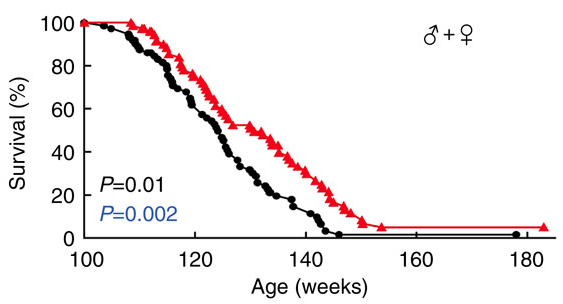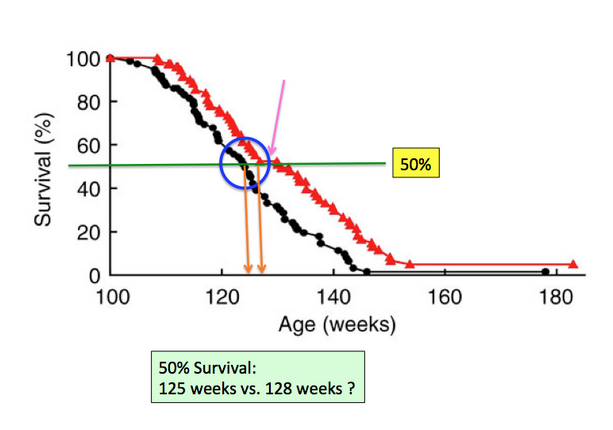It’s been all over the news.
Depending on the accuracy of the headline, you may conclude that worms live longer when exposed to glucosamine, mice live 10 percent longer when fed glucosamine or that YOU will live 8 years longer if you take the stuff.
As usual, the devil is in the headlines.
Some were pretty accurate: Glucosamine promotes longevity in worms and mice, study says (from the L.A. Times).
Some, not so much: Have Glucosamine To Increase Lifespan! (from News on Wellness)
So, to get to the bottom of this, I tried to read the entire paper. Which probably explains the PTSD I'm experiencing today. It reads like a biochemistry textbook (and is just about as long), and it is very difficult to find the data about life extension in aging mice that were fed glucosamine—mostly because these aren't any, just a graph.
Two main issues: The first is whether their data make sense. The second is a standard problem in drug discovery—the relevance of an animal model to a human disease or condition.
The original paper, which appeared in the April 8th issue of Nature Communications is rough going. The authors spend an enormous amount of time talking about some pretty heavy stuff, such as glucose metabolism, mitochondrial respiration, amino acid transporters, and cell signaling processes.
But in the 12 page paper, there is so little about the increased life span of mice that I had to go through it three times simply to find it, since it appears in one graph (three, if you count separating the data according to the sex of the mice) out of more than 40 graphs and figures.
There is much more about the life span of nematodes, which I am simply ignoring, since its relevance to the human condition is zero (or less). Let's look at the graph where the 10 percent increased mouse lifespan comes from (Figure 3c in the paper):

If you look at the mice, who were already 100 weeks old when they started receiving the glucosamine (red line), and follow it to the point where 100 percent of the animals are dead, it appears that the maximum life span for mice that were fed glucosamine was about 158 weeks. That number was about 142 weeks for the control group. (These numbers are eyeball estimates from the graph, since the actual data are not included in the paper. And I am treating the one mouse that apparently lived past 185 weeks as an outlier. Or Mighty Mouse).
But let's look at this graph in a different way:

In cell-based and animal tests, (LD50, for example) a very common and useful piece of information is what happens when you reach 50 percent of whatever effect you're looking to measure. So, if we examine the graph at the time when 50 percent of the mice had died things look a bit different.
The green line, where it intersects that red or black lines indicates the age at which 50 percent of the mice in each group had died. If you compare the glucosamine-treated and control groups at this point (orange arrows) it sure looks like the control group (approx. 125 weeks) and the treated group (approx. 128 weeks) aren't all that different (if at all).
Then, at 128 weeks, the lines start to diverge. But in an odd way. At week 128, there is a big right shift in the treated group—the flat part of the red line indicated by the pink arrow. This is uncharacteristic of graphed curves. And, once this separation occurs, the red and black lines more or less parallel each other until the end of the experiment.
What's going on here? I have no idea, but that horizontal section of the curve just doesn't look right. If taken at face value, you would have to believe that at week 128 something happened all at once to give the glucosamine-treated mice a longer life span. I can't explain it, but I don't like it either. The horizontal shift in the red line is screaming "artifact" at me. And, if not for this jump—as judged by the similar slopes of the red and black lines after week 128—it looks like both groups of animals would have lived about the same amount of time by the end of the experiment.
But, let's just accept that this is all real. Are you then going to live 10 percent (8 years) longer if you take glucosamine? For this to be true, the mouse model must be precisely predictive of what happens in humans.
Number of years that medicinal chemistry has been practiced: Over 100
Number of times this has actually happened: 0
Animal models of human diseases are useful tools—when they work. For example, if you infect a mouse with a particular strain of bacteria and the antibiotic-treated mice live while the controls die, there is a good chance that this same antibiotic will kill the same strain of bacteria in humans.
It is quite a different story with cancer. A widely-used model, a nude (no immune system) mouse with a human tumor grafted into its body is can be helpful in studying and comparing different potential anti-cancer drugs. It is not unusual for the tumors in these animals to completely disappear when treated with a compound. But this does not translate well to human cancers—not even close. Thus the saying "if people were mice there would be no more cancer."
Animal tests are merely guides. They can help you tweak your synthesis program in a different direction, and they can also help you choose between compounds that you might be considering for further development. They also give you information about exposure, metabolism and other pharmacokinetic parameters. But any medicinal chemist or biologist will tell you that while these models may best tools you have early in the discovery process, they are far from ideal, and must be treated accordingly. Drawing any sort of quantitive conclusion from a mouse test is just asking for trouble. In fact, there are many cases where substantial differences in toxicity or efficacy are seen when comparing mice to rats, let alone to humans.
So, I wouldn't be waiting in line to buy glucosamine just yet. Between the strange graph and the absence of any information about whether this is even a viable model, the chances of this study being relevant to human life span are vanishingly low. The experiments in the paper are very early in the drug discovery process. Something like 99 percent—and probably higher— of drug candidates at this stage will ultimately fail.
(Also, imagine the protocol for a clinical trial in humans: Take a bunch of people who are 60, divide them into treated and control groups and follow them for 20 years? I don't think so.)
This may be an interesting premise, but it is not newsworthy. It is way too soon.
Exception: I'm guessing that some people will live longer because of glucosamine. But it will be those who make and sell it and then retire to a stress-free life in a house in Maui overlooking the Pacific Ocean. With your money.





Comments